
Not that kind of shopping -- fish shopping :) Over Thanksgiving I had a chance to organize my thoughts on the topic of buying fish. Sorry this is a bit long -- I guess I had a lot of thoughts.
A good fish counter gives me the same thrill as a Provencal fabric market – all those beautiful colors and textures tempting me with possibilities. There is salmon, showing off its orange flesh accented by thin stripes of succulent fat. The bluefish is draped like gray velvet of a cozy robe. The stately halibut stands out like a bride in a white satin gown. Delicate fillets of sole are piled like transparent folds of chiffon. But I remember the times when fish shopping was scary, unpredictable, and smelling of disaster. Why? Let’s see:
- This little shack looks like it’s about to fall over. Is it safe to buy fish here?
- Is it bad that it smells fishy?
- What if the fish is not fresh and will make me sick?
- My recipe calls for “striped bass” and they don’t have it – help!
- How much fish do I need for 2 people?
- What on earth is “sable”?
Does that sound familiar? The worst part is that fish is not cheap, so buying an unfamiliar fish at $15/Lb might seem a bit risky. But luckily, I had an ally in my quest to buy and cook fish – the fishmonger.
The Fishmonger
Until I met Mike, salmon used to be my fish of choice. It’s reliably available, fairly inexpensive, and familiarly pink. But one day, I asked Mike if there is some other fish he can recommend for me to try. He raised one of his heavy dark eye brows and I noticed a sparkle in his eye. “The bluefish is really excellent today. It just came in.” I eyed the strange looking gray fish with hesitation. “What is it like?” I asked starting to regret my curiosity. Mike was sounding so enthusiastic about it that I would not have the guts to say no, and might have to take that strange critter home. “It’s delicate and very flavorful, Miss. And it’s almost impossible to dry out. How are we cooking it?” “I was going to broil it.” “Great! It’s also great grilled.”
I couldn’t have had a better introduction to bluefish. The success of my first venture beyond salmon helped me trust Mike and encouraged me to be nosy in fish markets. The amazing thing is that I never seem to run out of questions and the fishmongers never seem to tire of answering them. Here are some questions you can ask your fishmonger to break the ice.
If they are reluctant to answer them, consider going to another fish market.
Q: When did the fish come in?
A: A competent employee of a fish market should know (or be willing to find out) when a particular fish came in because it’s essential for telling you how long you can keep it before cooking. “Yesterday” is a perfectly good answer. Fin fish (unlike shellfish) is fresh for about 1 week after it was caught.
Q: How long can I keep it before cooking?
A: Fresh fish can be stored for at least 2 days in the fridge before cooking. If the fishmonger says you can only cook it today, the fish was stored too long at the fish market.
Q: What is this fish like?
A: A good fishmonger tasted most fish she sells. She should be able to give you a description of the texture, flavor, and fat content.
Q: What are some good ways to cook this fish?
A: If you are new to cooking fish, asking fishmonger for recommended cooking methods can steer you away from a disaster of grilled sole or poached swordfish. If you are in a mood to grill or in a mood for a light dinner of simple steamed fish, don’t hesitate to tell your fishmonger. They’ll often be ready with a great recommendation.
If the fishmonger can answer all those questions with confidence, you know you are in good hands. You’re more likely to encounter expert fishmongers in small Mom and Pop shops than in chain supermarkets, but you never know. Mike was a fishmonger in a regular Boston supermarket chain. Many supermarkets have excellent fish departments, particularly organic chains like Whole Foods. The trouble with non-organic chains is that they can be extremely inconsistent in the quality of their fish department from one store to the next. It all depends on the manager of their fish department, not on the brand of the supermarket chain. This brings us to the topic of what a good fish market looks like.
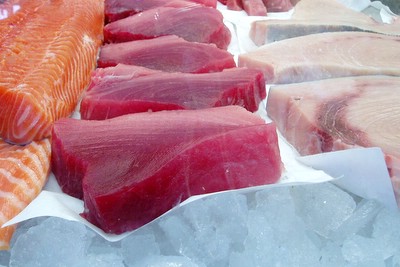
The Fish Market
Here is a check list you can use to evaluate the fish market.
- Floors should be clean.
- The market should be well lit so that you can see the fish well.
- All steaks and skinless fillets should be stored on cookie sheets or parchment paper set on ice. They should not come in direct contact with ice so that their flesh is not damaged by melted ice.
- Large fillets with skin, like a whole side of salmon can either be stored like skinless fillets or placed directly on ice since the skin creates a barrier between the flesh and ice.
- All whole fish should be buried directly in ice. Since they have the skin to protect them from water.
- The fish should have a very mild smell or none at all. You can ask the fishmonger to hold out a fillet so that you can smell it. If you don’t feel comfortable doing that, smell the fish when you get home.
- Whole fish should have clear eyes and bright red gills without any brown discoloration.
- There should be no gaps between the flakes of fillets (except for the center of the fillet where the pin bones were removed) and fillets should be glistening and feel firm to the touch. You can ask the fish monger to press the fillet with their fingers. If the flesh doesn’t bounce right back and you can see the indentation where the fingers touched the fish, the fish was mishandled. If you don’t feel comfortable asking the fishmonger to do that, check the fish when you get home.
Fish on Mondays
Monday is not the best day to buy fish. Fish markets do not get deliveries on Monday because fishermen don’t fish on Sunday. Even in the best fish markets, the selection of fish on Monday is likely to be smaller than on other days. It’s perfectly safe to buy and eat fish on Monday, but I don’t recommend keeping it until the next day.
After talking to several fishmongers in the Boston area, I found out that this "don't buy fish on a Monday" rule no longer applies. Some fish are actually delivered on Mondays. It all depends on where they are coming from. Since fin fish stay fresh for about a week after they are caught, it's perfectly reasonable to buy them on any day of the week.
Ready, Set, Cook!
Ready to cook fish is a pleasure to bring home. Here are some chores a fishmonger would be happy to help you with at no extra charge:
- Cleaning a whole fish (scaling, gutting, removing gills, and fins)
- Filleting a whole fish
- Removing skin from fillets
Just remember to ask!
Finding a fish market near you
Word of mouth is the best way to find a good fish market. Ask your co-workers, neighbors, and friends. If you like fish dishes at a local restaurant, ask the chef for advice.
With growing popularity of food related newsgroups on the internet, the “word of mouth” got a whole new meaning. Here are two newsgroups organized by geographic area where you can post questions:
www.chowhound.com
www.egullet.com
 Of all the great appetizer I picked up from Ruth-Anne Adams while working at Casablanca in Cambridge, this one is my favorite. These little tartlets are great crowd pleasers and reheat beautifully if made in advance. What better way to welcome your guests to the holiday table than a combination of musky figs and creamy blue cheese! Serve them with a bold, fruity Shiraz as an hors-d'oeuvre or the first course.
Of all the great appetizer I picked up from Ruth-Anne Adams while working at Casablanca in Cambridge, this one is my favorite. These little tartlets are great crowd pleasers and reheat beautifully if made in advance. What better way to welcome your guests to the holiday table than a combination of musky figs and creamy blue cheese! Serve them with a bold, fruity Shiraz as an hors-d'oeuvre or the first course.
 Not that kind of shopping -- fish shopping :) Over Thanksgiving I had a chance to organize my thoughts on the topic of buying fish. Sorry this is a bit long -- I guess I had a lot of thoughts.
Not that kind of shopping -- fish shopping :) Over Thanksgiving I had a chance to organize my thoughts on the topic of buying fish. Sorry this is a bit long -- I guess I had a lot of thoughts.
 In spite of what the title of the blog might imply, I love salmon. One of my students just reminded me about the Salmon Teriyaki dish we made in One Fish, Two Fish, Red Fish, Blue Fish class, and I was inspired to make it for dinner. It was the first "real" fish dish that I learned to make in college, and it's still one of my favorites. Thanks for a great idea Natalie!
In spite of what the title of the blog might imply, I love salmon. One of my students just reminded me about the Salmon Teriyaki dish we made in One Fish, Two Fish, Red Fish, Blue Fish class, and I was inspired to make it for dinner. It was the first "real" fish dish that I learned to make in college, and it's still one of my favorites. Thanks for a great idea Natalie! 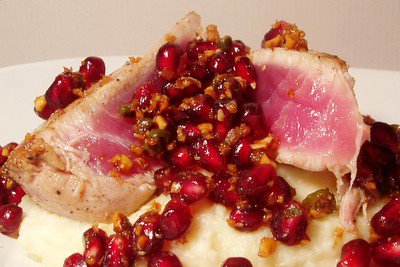
 Meet Dobby the Celery Root. Yes, I know -- only his own mother could love him. But when mashed with a little cream and butter, not only is he delicious with a little astringency reminiscent of celery, but looks appetizing enough to compete with mashed potatoes. This creamy little side dish is a perfect accompaniment for fish and lighter meats since it's not as ladenly starchy as potatoes.
Meet Dobby the Celery Root. Yes, I know -- only his own mother could love him. But when mashed with a little cream and butter, not only is he delicious with a little astringency reminiscent of celery, but looks appetizing enough to compete with mashed potatoes. This creamy little side dish is a perfect accompaniment for fish and lighter meats since it's not as ladenly starchy as potatoes.
 I had a craving for butternut squash ravioli for weeks now, but haven't had time to make my own pasta dough. So, when I saw Diana's post over at
I had a craving for butternut squash ravioli for weeks now, but haven't had time to make my own pasta dough. So, when I saw Diana's post over at 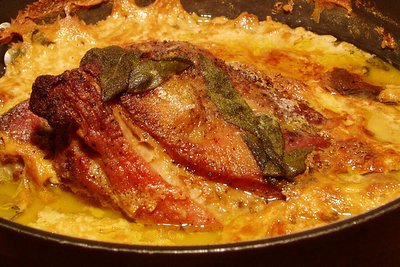 Boston Butt is not really a butt -- it's a pig's shoulder. It's one of the best cuts to use for a braise since it's tough and fatty and has lots of connective tissue. After 3-4 hours in the pot, it turns into fall-of-the-bone deliciousness. There are many great braising recipes for pork, but none as wonderful in their simplicity as Bolognese Style Pork Braised in Milk.
Boston Butt is not really a butt -- it's a pig's shoulder. It's one of the best cuts to use for a braise since it's tough and fatty and has lots of connective tissue. After 3-4 hours in the pot, it turns into fall-of-the-bone deliciousness. There are many great braising recipes for pork, but none as wonderful in their simplicity as Bolognese Style Pork Braised in Milk.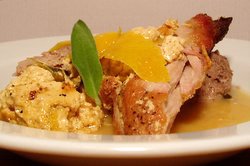
 Here is a recipe for the pizza I
Here is a recipe for the pizza I 

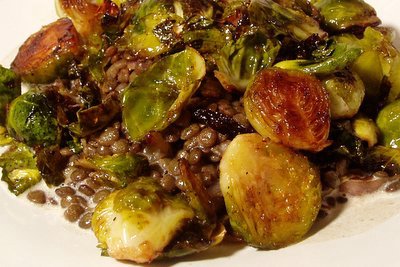 Lentils and Brussel Sprouts -- every kid's nightmare and my delight. I think the reason American kids have such immense dislike of all things green is that they've been fed steamed vegetables their entire childhood. So if you've had some bad childhood experiences with brussel sprouts, try this recipe. It's better than therapy for recovering from bad childhood memories.
Lentils and Brussel Sprouts -- every kid's nightmare and my delight. I think the reason American kids have such immense dislike of all things green is that they've been fed steamed vegetables their entire childhood. So if you've had some bad childhood experiences with brussel sprouts, try this recipe. It's better than therapy for recovering from bad childhood memories. I did it--I taught a cooking class in my own kitchen! After teaching at CCAE for several years, I decided it would be fun to offer classes to groups of 6-8 people who know each other and like playing with food. It was also a welcome change to cook with my own equipment without having to drag it somewhere else. We cooked, we drank wine, we laughed, we took pictures, and we had a great time. The only problem was that we ended up with too much food.
I did it--I taught a cooking class in my own kitchen! After teaching at CCAE for several years, I decided it would be fun to offer classes to groups of 6-8 people who know each other and like playing with food. It was also a welcome change to cook with my own equipment without having to drag it somewhere else. We cooked, we drank wine, we laughed, we took pictures, and we had a great time. The only problem was that we ended up with too much food. Here we are enjoying our salads, wine, and cheese
Here we are enjoying our salads, wine, and cheese

 We learned all kinds of cooking techniques: from infusing butter with sage to testing fish for doneness. The most important tip was using the "claw grip" to cut veggies and herbs -- that's how we made sure to slice the onions, not our fingers.
We learned all kinds of cooking techniques: from infusing butter with sage to testing fish for doneness. The most important tip was using the "claw grip" to cut veggies and herbs -- that's how we made sure to slice the onions, not our fingers.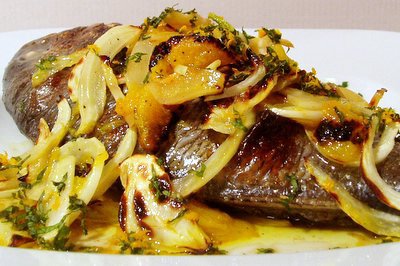 Sea Bream is a small fish with flavorful white flesh and delectable skin. It often appears in fish markets under its European names: Dorade, Dorado, and Orata. It weights about 1 Lb, yielding 6-8 oz of meat -- just right for one portion.
Sea Bream is a small fish with flavorful white flesh and delectable skin. It often appears in fish markets under its European names: Dorade, Dorado, and Orata. It weights about 1 Lb, yielding 6-8 oz of meat -- just right for one portion. Stepping into the New Deal Fish Market in East Cambridge always makes me smile. Whole Foods might have good quality fish, but do they greet me by name? Do they remember which fish I bought last week? Do they take care scaling and gutting my fish as if they were going to cook it themselves? That’s why I love the New Deal Fish Market – they treat every customer like family, they educate people about fish, and they take pride in what they do.
Stepping into the New Deal Fish Market in East Cambridge always makes me smile. Whole Foods might have good quality fish, but do they greet me by name? Do they remember which fish I bought last week? Do they take care scaling and gutting my fish as if they were going to cook it themselves? That’s why I love the New Deal Fish Market – they treat every customer like family, they educate people about fish, and they take pride in what they do.